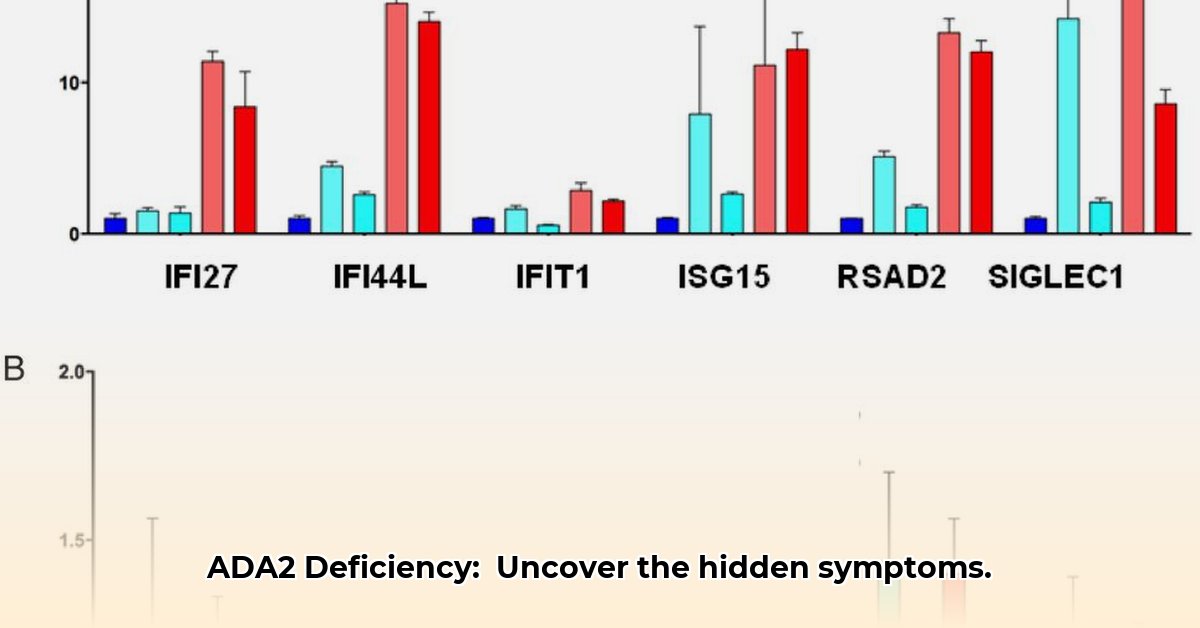
Understanding Ada2 Deficiency (DADA2)
DADA2, or Adenosine Deaminase 2 Deficiency, is a rare inherited condition affecting the body's ability to produce a vital enzyme. This enzyme is crucial for the proper functioning of the immune system and blood vessels. Think of it like a missing key part in a complex machine; without it, things don't work as they should. A faulty ADA2 gene causes the deficiency, leading to a range of symptoms, often making diagnosis challenging. It's not contagious, and it's important to understand that it's not a sign of something you've done wrong.
Diagnosing Ada2 Deficiency: A Multi-Step Process
Diagnosing DADA2 can be like piecing together a jigsaw puzzle with many missing pieces. The varied presentation of symptoms makes it tricky to pinpoint. The process typically involves:
Detailed medical history and physical examination: Your doctor will assess your symptoms and family medical history. This helps establish a baseline understanding of your health and possible hereditary factors.
Genetic testing: A genetic test will look for mutations in the ADA2 gene, confirming or ruling out the diagnosis. This is vital for accurate diagnosis and treatment planning.
Enzyme activity assays: Blood tests measure the levels of the ADA2 enzyme. Low levels indicate the deficiency. This helps to quantify the extent of the enzyme deficiency.
The wide range of symptoms often leads to delayed diagnosis, highlighting the importance of early consultation with specialists if you experience symptoms suggestive of DADA2.
Treatment Options: Tailoring Care to Individual Needs
Treatment for DADA2 depends on the severity of symptoms and the extent to which different parts of the body are affected. Two primary treatment approaches exist:
Tumor Necrosis Factor (TNF) inhibitors: These medications, such as etanercept or adalimumab, help control inflammation and reduce the severity of vasculitis (inflammation of the blood vessels). They work by targeting specific proteins involved in the inflammatory process. Think of them as calming the inflammation down, preventing further damage. Effectiveness varies between individuals.
Hematopoietic stem cell transplantation (HSCT): This more invasive procedure replaces faulty blood stem cells with healthy ones. It's a more significant undertaking often reserved for severe cases but offers the potential for a cure. This is comparable to a complete system overhaul and rebuild.
Treatment selection is a collaborative process between the patient, their family, medical professionals, and specialists. The decision considers the individual's health status and the severity and location of the inflammation.
Treatment Decision Matrix:
| Symptom Severity | Blood Vessel Involvement | Immune System Involvement | Recommended Treatment |
|---|---|---|---|
| Mild | Minimal | None | TNF inhibitors |
| Moderate | Significant | Minimal | TNF inhibitors, potentially HSCT consideration |
| Severe | Extensive | Significant | HSCT strongly recommended |
Remember, this is a simplified overview. A proper risk assessment must be conducted with input from your specialist team which will take individual circumstances into account - including the level of organ damage in addition to the elements in the above table.
Living with DADA2: Practical Advice and Support
Living with DADA2 requires a proactive and holistic approach. Here's what you can do:
Regular check-ups: Monitor your progress and discuss treatment options with a doctor, and be sure to follow treatment plans.
Build a support network: Connect with other families and support groups. Sharing experiences and finding shared solutions can greatly improve mental well-being.
Manage your symptoms: Implement lifestyle changes and stress reduction strategies advised by your physician. This may include managing stress and getting enough rest.
Stay informed: Keep up-to-date on the latest research and treatment options.
The Future of DADA2 Research: Exploring New Therapies
Research offers continued hope for better treatments and outcomes. Current avenues of research include:
Gene therapy: This exciting area focuses on correcting the faulty ADA2 gene itself. This is about addressing the root cause of the problem.
Enzyme replacement therapy: This approach aims to supplement the missing enzyme, potentially alleviating symptoms directly.
These advancements hold incredible potential for improved treatment solutions in the future, offering a brighter outlook for improved quality of life for individuals and families affected by DADA2.
Does early diagnosis improve prognosis in DADA2? Research suggests it does, making proactive healthcare engagement crucial.